The Fender Jaguar and Mustang are two of Fender’s most iconic guitars. Not as popular or instantly recognizable as a Stratocaster or Telecaster, they still have a rich history and have been played by some of the most famous guitarists.
But you might not be as familiar with them as those more well known guitars. And you may be wondering what the differences is between the two and which would be best for you.
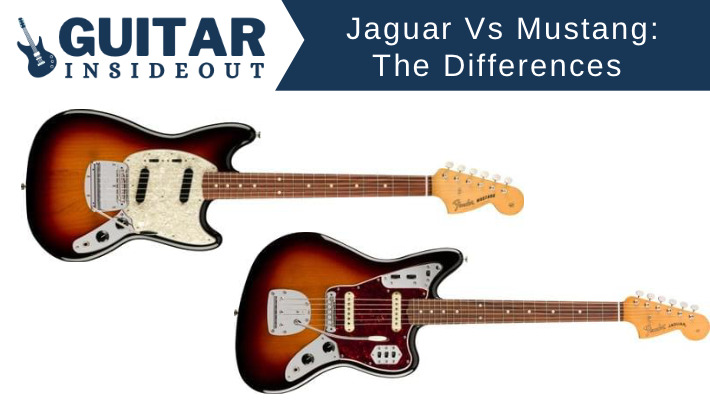
They’re both great guitars but they have their own sound, feel and different playability. And if you are looking to play a certain style or genre of music then one may definitely be a better choice than the other.
So let’s take a look at the differences between the Mustang and Jaguar, see the how they measure up and how to decide which will be suited to you.
Main Differences Between Jaguar vs Mustang
The Main Differences Between the Jaguar vs Mustang are:
- The Jaguar is very versatile with a complex set of controls that give a greater variety of tones whereas the Mustang is a lot more straightforward.
- The Mustang is a simple guitar with basic controls, a smaller body and a very classic Fender tone, whereas the Jaguar has a broader choice of clear and bright tones.
- They both have offset bodies but are differently shaped.
- The Mustang is much lighter than the Jaguar.
- Jaguar bridges can be problematic and awkward, with strings popping out and tuning stability issues.
Both guitars have offset bodies and 24″ short scale necks, meaning the length of the neck (with distance between the nut and the saddle) is shorter.
So as they share some similarities how they play and feel will be more about the body and neck shape as well as how they’re setup.
When you are deciding which is going to meet your needs you should think about what sound you’re after and what style of music you will be playing.
So let’s get into the real nitty gritty of each guitar and see the major differences between them.
Body
One of the most obvious differences is the body shape of the two. As mentioned above they’re both offset guitars, offset referring to the distinctive shape of the body.
Offset guitars have the top and bottom halves of their body offset from one another. They’re asymmetrical with one side more noticeable accentuated.
You can clearly see from the image below that their bodies are shaped very differently:
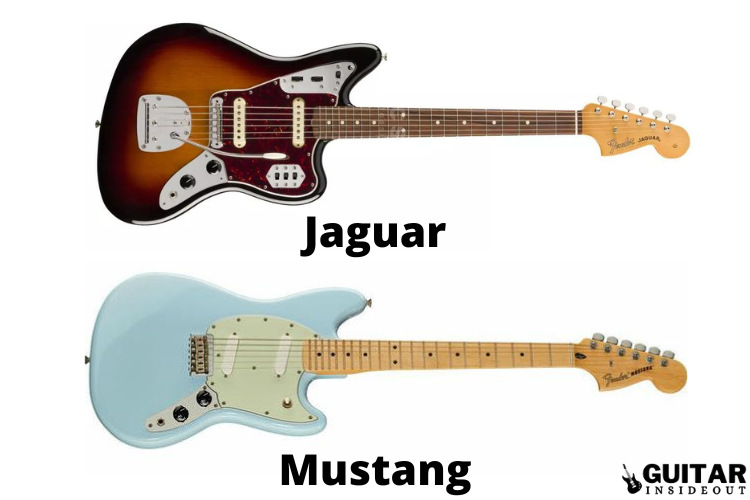
The Mustang body is smaller than the Jaguar. The Jaguar is around 2 inches wider at the lower bout and is slightly deeper.
Which you prefer will come down to preference. The small body and short scale neck of the Mustang can be awkward for taller and bigger people but suits those who are fairly small or have small hands.
However it is very light which if you’re playing for long periods of time standing up can make a big difference. Much less chance of back ache with the Mustang!
It’s always recommend that if you can you try any guitar before you buy because of the different feel, weight, neck shape etc. Some will suit you and others won’t.
The most commonly used woods for Mustangs are poplar and basswood with a few reissues being made from ash. The original Mustangs were mostly made from poplar and although some reissues have been basswood many are still poplar.
Jaguars are mainly made from alder with some Japanese reissues being made from basswood.
Alder is lightweight and bright sounding, with good sustain, attack and a bit more emphasis in the upper midrange. Basswood is also very lightweight but has less upper-midrange with a more even and round midrange. It’s considered to be a good match for humbucker pickups as well.
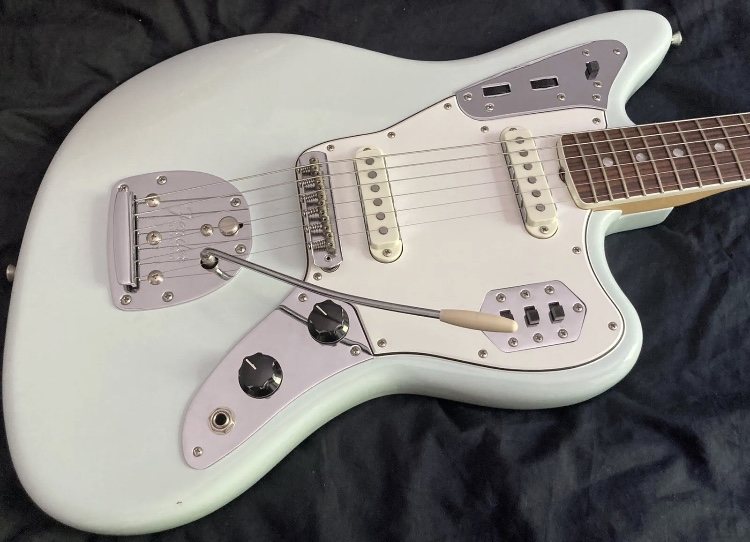
Neck
The necks on the Mustangs and Jaguars are both bolt-on, made from maple and feature a ‘C’ profile or shape.
Fretboards on the Mustangs were traditionally rosewood (and occasionally maple) but since 2017 have been pau ferro due to the CITES restrictions on trading rosewood as it’s become endangered. Jaguar fretboards are more varied with rosewood, ebony, maple and Indian laurel all being used on different models (rosewood was also replaced in 2017 due to the CITES restrictions).
The maple neck and fretboard will give a bit more bite to the sound whereas the rosewood or pau ferro is smoother and more rounded sounding.
Both instruments have 22 medium jumbo frets with a 24 inch scale, a 7.25 inch fretboard radius (although some modern versions have a 9.5 inch radius) and a 1.5 inch nut width. They both share the same classic Fender headstock as well.

Pickups
The Fender Jaguar and Mustang originally came with 2 single coil pickups but there have since been reissues with both P90’s humbuckers. The Mustang also has a reissue with a humbucker in the bridge and regular single coil at the neck.
You’ll notice the Mustang single coil pickups are angled in comparison to the straight pickups of the Jaguars. Whereas the Jaguars pickups come with metal trays surrounding them.
The Jaguar has a very unique selector for its pickups (which we will get on to further down) and the Mustang has the more standard 3 position selector switch.
Both sets of pickups were designed specifically for the respective guitars. So each will have their own different tone (discussed further under the tone section).
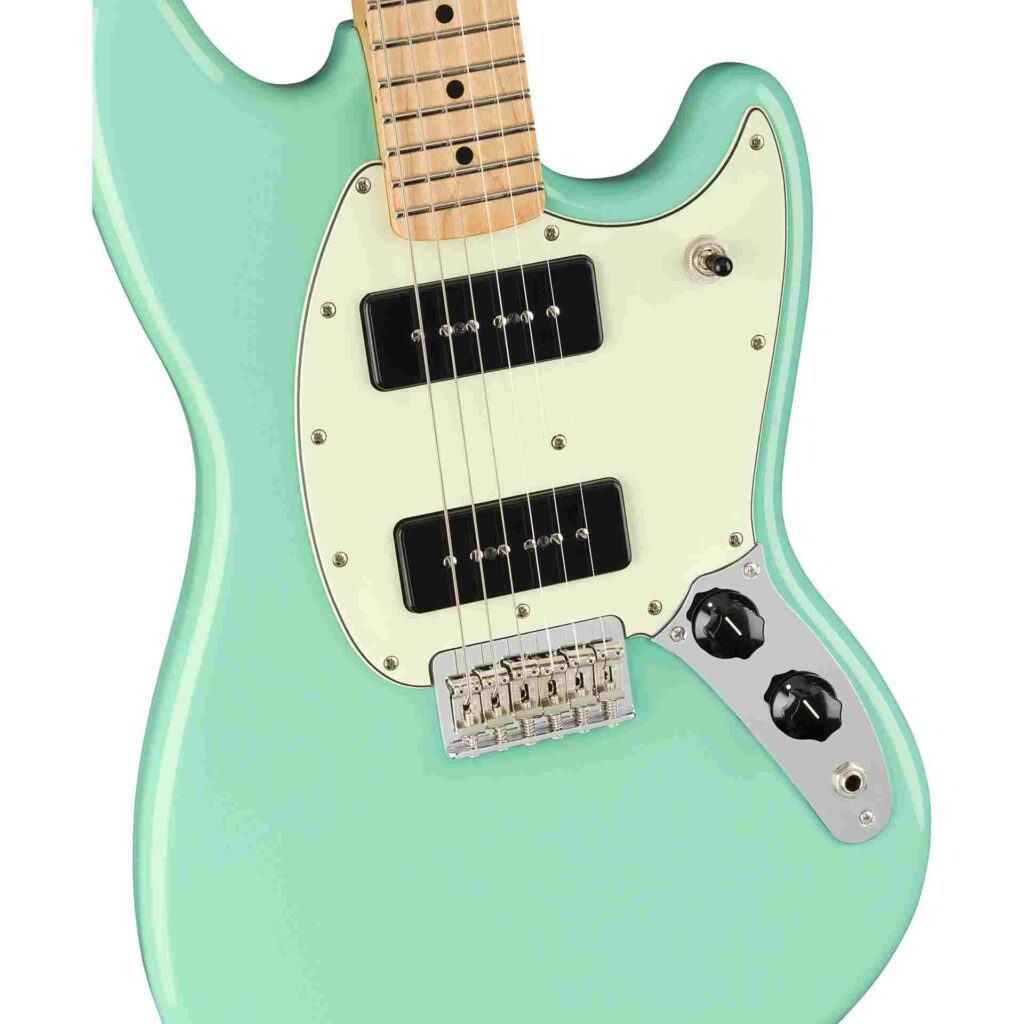
Hardware
One big difference is the bridges on Mustang and Jaguar. The original Fender Mustang had the “Fender Dynamic Vibrato” and a bridge with saddles that only a single string slot. This is very different to every other Fender guitar which had bridge saddles with several slots.
The Jaguar however has its own bridge issues. A poor design in the tremolo for both Jaguars and Jazzmasters is that the angle behind the bridge doesn’t create enough tension to keep the strings in their slots. So if you play with any force or bend the strings then they pop out. (The Classic Player Jaguar has a different bridge and tremolo to try and solve these issues)
A popular solution is to replace the bridges on Jaguars and Jazzmasters with a Mustang bridge. They fit perfectly and have fewer parts and better slots for the strings which make a big difference.
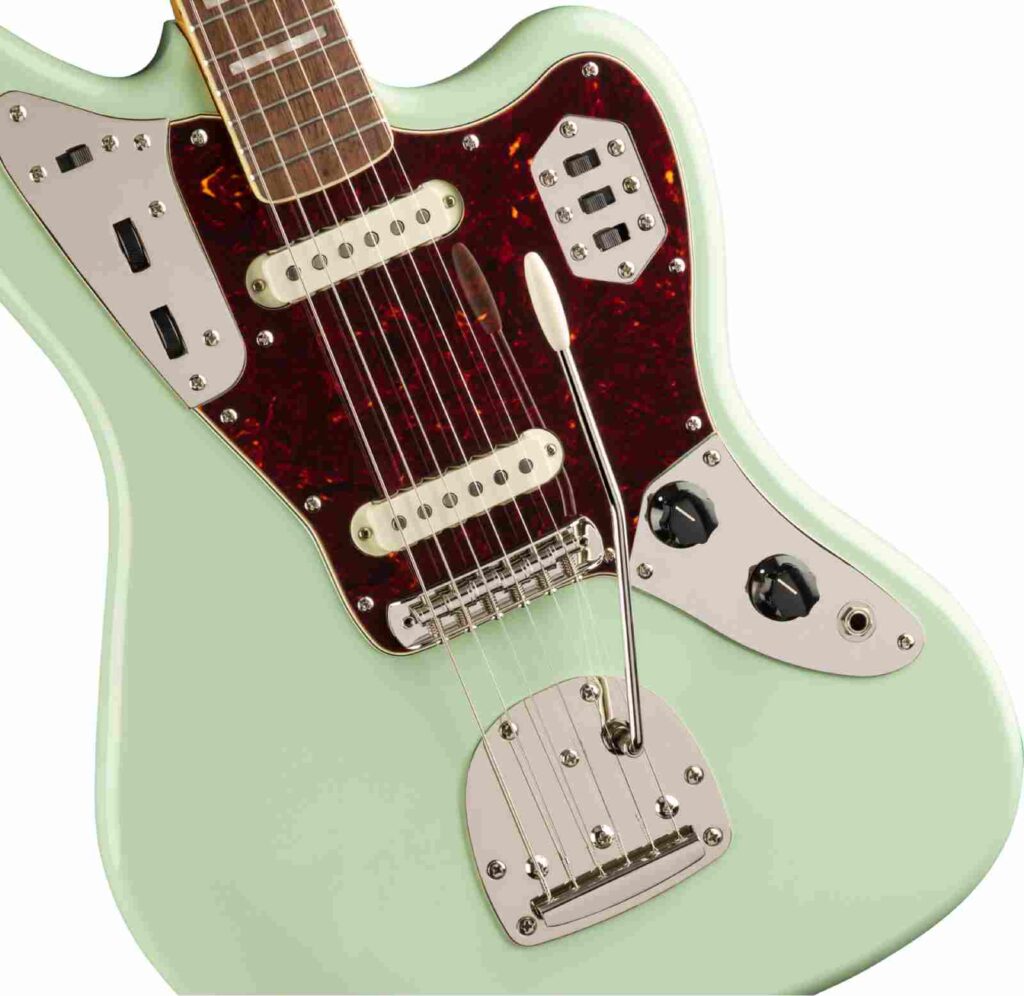
Wiring and Electronics
The Fender Jaguar has extremely unique electronics and features. Just looking at it you can see it has far more switches than most guitars.
But what do they do? Well the Jaguar has something called a dual circuit which can be selected by the up-down switch at the top of the guitar.
When down the ‘lead circuit’ is engaged it activates both pickups and allows them to be controlled by the three slide switches found on a chrome plate on the lower bout.
When the switch is up the ‘rhythm circuit’ is engaged. This only activates the neck pickup, with the bridge pickup becoming deactivated and the lower-bout volume and tone controls going inactive as well. The neck pickup is then controlled by the switches on the upper bout’s chrome plate.
The lead circuit has 3 switches: the first is a “strangle” switch that cuts the mid tone. The second turns the bridge pickup on and off. And the third switches the neck pickup on and off.
The rhythm circuit, found on the upper horn, has a single switch that can engage the neck pickup. Alongside that is two wheels that adjust the volume and tone. It’s known as being very dark sounding.
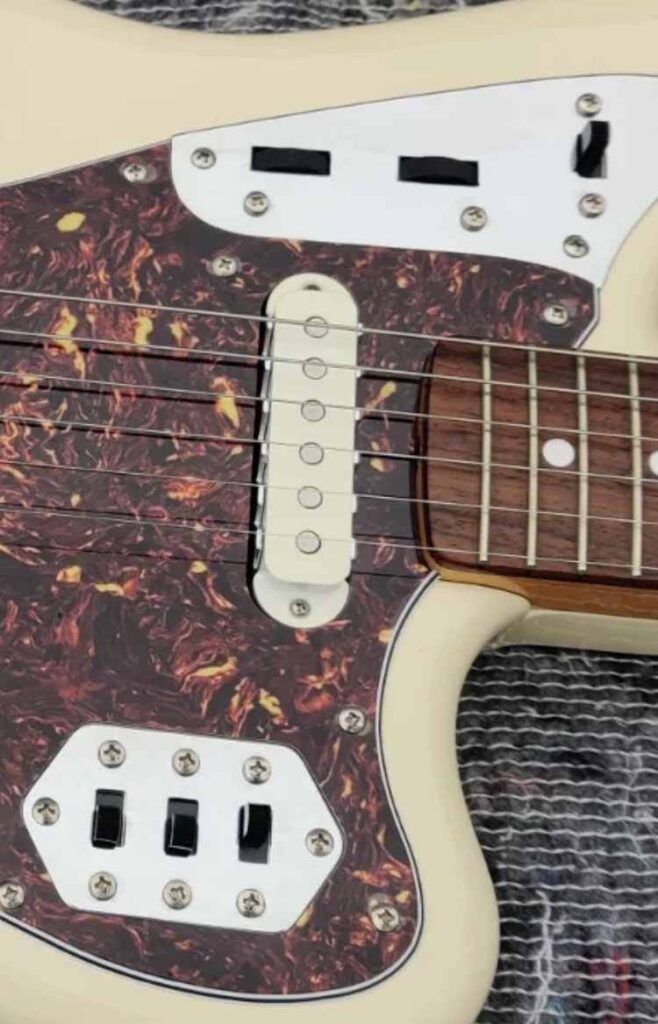
The Mustang in comparison is relatively basic. It does though feature pickup switches letting you turn the pickups on or off and use them in parallel and isolation. So you can blend the sound of the pickups or use them in isolation.
You can also reverse the phase of each pickup, playing them out of phase and getting a distinctive “choked” type of sound.
Some more modern versions of the Mustang however, including the American Performer, use a regular 3 way toggle switch and not the selection described above.
Tone
The Jaguar has a pretty unique tone and there isn’t really another guitar that sounds like it. This might be because of the two circuits and many different selections you can have.
But they can go from very bright and with a lot of bite to much warmer sounding. The attack on a Jaguar is extremely pronounced as well with individual notes very articulate.
Again it depends on which circuit you are using though. The rhythm circuit is much darker and the lead very bright. So switching between the two has a big effect on the tone you get.
They can also be a lot chunkier and more aggressive than something like a regular Strat.
A Jaguar doesn’t have much sustain though, or resonance. That’s all part of ‘their sound’ but isn’t for everyone.
A Mustang’s sound however is far more straightforward. They’re bright, quite jangly but the single coils pickups are lovely and warm.
Compared to a Jaguar the Mustang is definitely more mellow and janglier. The out of phase pickups allow for some interesting sounds and actually if you use the two pickups in phase then the Mustang does a pretty good Strat impersonation (albeit warmer).
They breakup surprisingly well though and can still rock out if that’s what you want.
This video gives a very clear idea of the two different guitars and how they sound side by side:
Famous Guitarists Who Play Jaguar’s
These are just a few of the most notable guitarists who play or have played Jaguars:
- John Frusciante (Red Hot Chili Peppers)
- Billy Corgan (Smashing Pumpkins)
- Kevin Shields and Bilinda Butcher (My Bloody Valentine)
- Kurt Cobain (Nirvana)
- Jonny Buckland (Coldplay)
- PJ Harvey
- Win Butler (Arcade Fire)
- Brian Molko (Placebo)
- Johnny Marr (The Smiths)
- Thurston Moore (Sonic Youth)
- Elvis Costello
- Lindsey Jordan (Snail Mail)
- Tom Verlaine (Television)

Famous Guitarists Who Play Mustang’s
These are just a selection of the most notable guitarists who have played and still play a Fender Mustang:
- Kurt Cobain (Nirvana)
- Matty Healy (The 1975)
- Omar Rodríguez-López (The Mars Volta and At the Drive-In)
- Norah Jones
- Brendon Urie (Panic at the Disco)
- Frank Black (Pixies)
- Ben Gibbard (Death Cab for Cutie)
- David Byrne (Talking Heads)
- Liz Phair
- Mac DeMarco

Fender Jaguar or Mustang
If that was a lot to read and you’d like a quick overview of the differences between the Jaguar and Mustang:
Jaguar Features
- Scale length: 24 inches
- Pickups: 2 single coils, 2 humbuckers
- Body wood: Alder (sometimes ash)
- Vibrato bridge: Yes
Mustang Features
- Scale length: 24 inches
- Pickups: 2 single coils, 2 humbuckers, 1 single coil and 1 humbucker
- Body wood: Poplar and basswood
- Vibrato bridge: Yes
Which is Best for You?
You may already have decided which you think is the best of the two for you. But wait just a second! Take a breath. Because it’s almost always best to try a guitar before you buy it.
It doesn’t matter if the Jaguar is your dream guitar and ticks every box for what you want. It’s still better to try it in person, get a feel for how it and other guitars play and sound before you make that final decision.
Whilst one guitar on paper might seem like it’s perfect the reality can often be surprising. Jaguars and Mustangs are very different guitars, and you may find that you love the sound of one but the feel of the other.
But there’s no way of knowing for sure without actually getting your hands on them and letting your ears hear them.
And while Jaguars are known for indie rock and Mustangs alternative rock and grunge that shouldn’t influence your decision. They’ve also been used across many different genres of music and with great success.
So don’t be swayed by other factors. It should all come down to which guitar feels right when you play it and sounds the way you imagined.

History of the Jaguar and Mustang
Both the Fender Jaguar and Mustang have a long history. Let’s take a closer look at their origins and see how they started.
Jaguar History
Originally introduced in 1962, the Jaguar followed on from the iconic Stratocaster and Telecaster and came hot on the heels of the Jazzmaster. It was the highest end model that Fender had produced at that point and was packed full of features setting it apart from the more straightforward Strat and Tele.
Despite its unique features it failed to gain the sort of popularity of the Stratocaster and Telecaster, which dominated the guitar market. It found a home amongst surf guitarists but only as that styled of music began to fade.
Removed from Fenders lineup in the 1970’s it took the rise of punk to revive the Jaguars fortunes. Punk guitarists couldn’t afford a Strat or Tele but a Jaguar was a genuine Fender that was going for cheap.
This meant that through the 1980’s into the 90’s punk and alternative guitarists were regularly seen playing Jaguars, which in turn increased their popularity. They returned to the Fender lineup and haven’t looked back since.
Mustang History
The Fender Mustang was a guitar intended for students. Released in 1965 it followed the other student beginner guitars the Duo Sonic and Musicmaster.
Originally featuring only 22 frets and with a price that reflected its student status it was a favorite amongst beginners.
Production of the Mustang ended in 1982 but by 1990 it was being reissued. Due to its low price it quickly became the guitar of choice for alternative and grunge bands.
Since then more versions with different pickup configurations and controls have been realised. It may not have the same iconic status as the Stratocaster or Telecaster but the Mustang remains an important part of Fenders history.

Frequently Asked Questions
Is the Jaguar or Mustang Easier to Play?
It depends. The Mustang is very light and comfortable but because it’s so small with a short scale neck it can be too small for some people. If you have small hands and fingers though it’ll be ideal.
The Jaguar is a broader and more substantial guitar but that doesn’t make it uncomfortable. The same short scale neck means it’s playability is similar.
The Jaguar is probably the slightly better option just because it will suit most people whereas the Mustang can feel just too small for some.
Which Guitar Came First, the Jaguar or the Mustang?
The Jaguar was released in 1962 in comparison to the Mustang which was released in 1964. So the Jaguar is 2 years older than the Mustang.
Conclusion
Both the Jaguar and Mustang are great guitars. Unique looking and with interesting tones, they are similar but with noticeable differences.
They do different jobs and don’t sound alike but once you’ve tried them both you’ll probably find yourself favoring one over the other.
Whichever you choose though you will no doubt be satisfied. They’ve been a staple amongst many musicians and rock stars for years really you can’t go wrong.